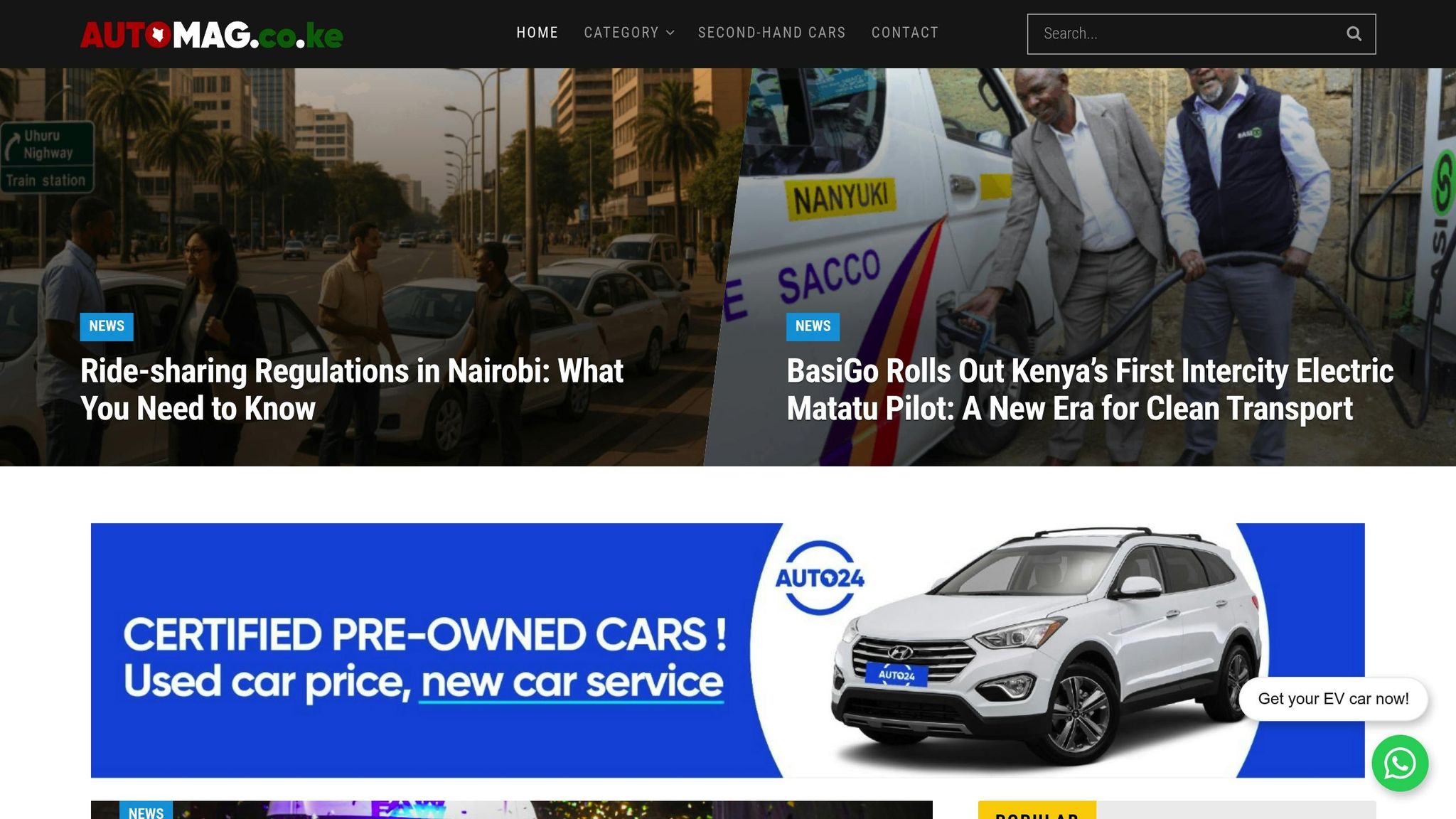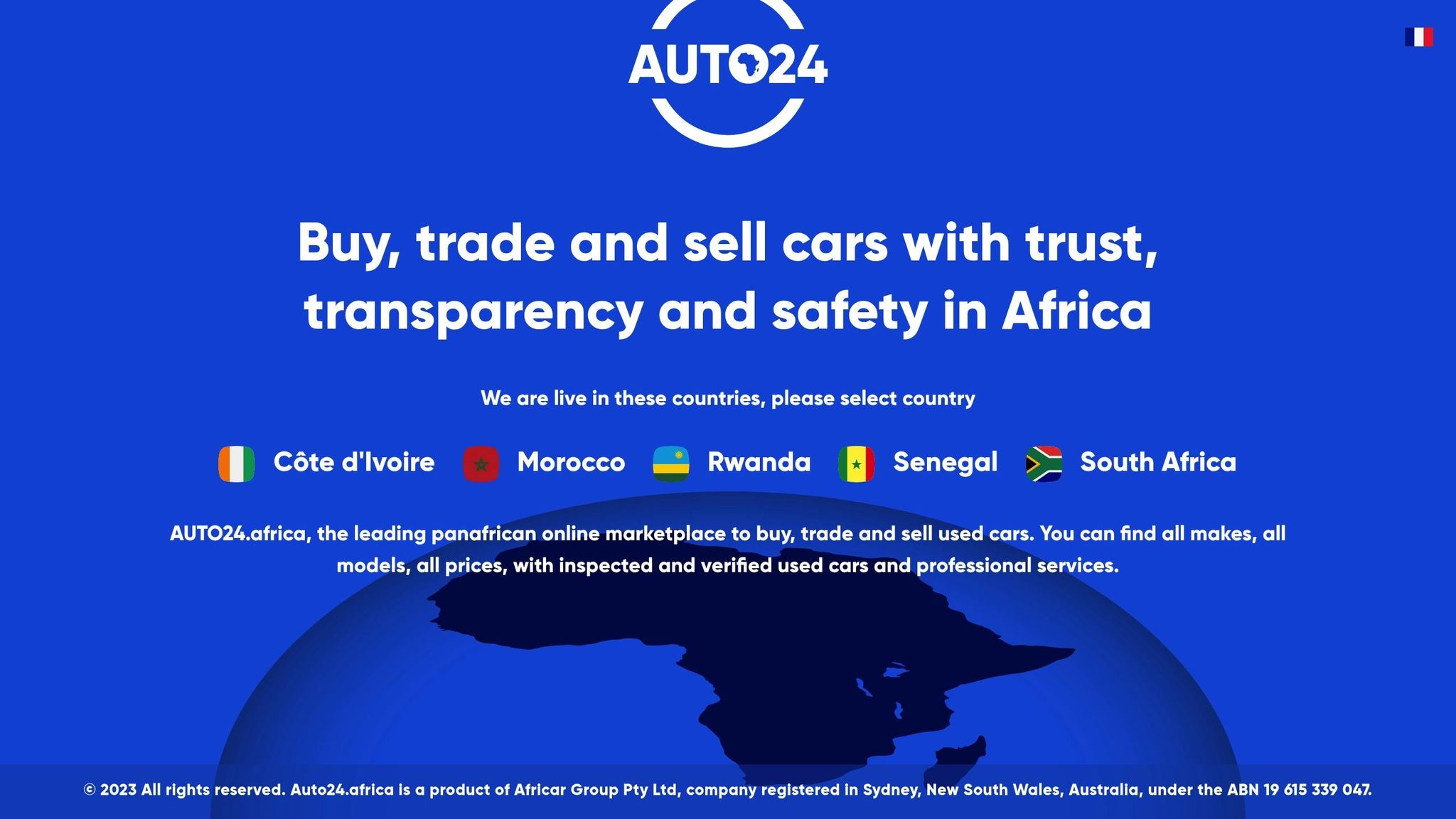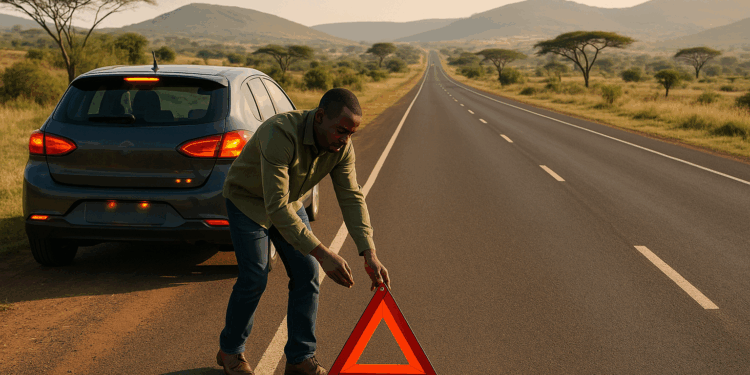Breaking down on a Kenyan highway can be stressful, but staying safe and prepared can make all the difference. Here’s what you need to know:
- Move to Safety: If possible, steer your car to the shoulder or a safe spot away from traffic. If the car won’t move, stay inside with your seatbelt on.
- Signal to Others: Turn on hazard lights immediately. Use reflective triangles and wear a high-visibility vest if stepping out.
- Carry Essentials: Keep a basic toolkit, jumper cables, flashlight, first aid kit, water, snacks, warning triangles, and a power bank in your car.
- Call for Help: Save roadside assistance and towing service numbers. Inform family or friends of your location and situation.
- Be Cautious in Remote Areas: Charge your phone, download offline maps, and stay with your car if stranded in areas with poor signal.
- Stay Visible at Night: Use hazard lights, reflective gear, and triangles. Avoid leaving the car unless absolutely safe.
Preparation is key to handling breakdowns safely and efficiently. Always plan ahead and keep emergency contacts handy.
How to set up safety triangles: Safety Tips for Truckers
Immediate Safety Steps
When your car breaks down on a Kenyan highway, your first concern should be ensuring your safety. Acting quickly can help prevent a minor inconvenience from turning into a dangerous situation. Here are some steps to minimize immediate risks.
Move Your Vehicle to a Safe Spot
If your car is still drivable, steer it to a secure location, such as the shoulder of the road or a nearby parking lot, away from moving traffic. Once parked, engage the parking brake right away.
If the car won’t move, stay inside and focus on your safety. Avoid the temptation to push a stalled vehicle on a busy highway – it’s far too risky with oncoming traffic.
Stay Inside the Vehicle When Unsafe
In many cases, staying inside your car is the safest choice, especially on busy highways or at night. Your car provides a layer of protection and ensures you’re visible to other drivers. Keep the doors locked and your seatbelt fastened while you wait. Only step out if you’re certain it’s safe to do so, such as on the side away from traffic or if there’s a secure area nearby.
Use Hazard Warning Lights
Turn on your hazard lights as soon as your car breaks down. These flashing lights signal to other drivers that your vehicle is stationary, giving them time to slow down and safely navigate around you. Keep the hazard lights on until help arrives or until you’re able to move your car to a safer location.
Required Tools and Equipment to Carry
Having the right tools in your vehicle can make a huge difference if you face a breakdown. Here’s what you should keep on hand for effective roadside management.
Reflective Warning Triangles and High-Visibility Vests
Always carry reflective warning triangles. These can be placed a safe distance behind your vehicle to alert approaching drivers, especially in bad weather or low visibility. Pair this with a high-visibility vest to ensure you’re easily seen when stepping out of your car. Keeping an extra triangle in your trunk is a smart move – it’s better to have one ready than to realize you need it during an emergency.
Basic Toolkit and Emergency Items
Your emergency kit should cover both mechanical fixes and personal safety. Start with heavy-duty jumper cables (about 12 feet long) to handle a dead battery.
Other must-haves include:
- Phillips and flathead screwdrivers
- Adjustable wrenches
- Pliers
- A tire pressure gauge
A 12V portable air compressor is also a great addition. It can reinflate a slowly leaking tire, giving you enough time to reach a service station.
For personal safety and comfort, pack a first aid kit, bottled water, and non-perishable snacks in case of long delays. An LED flashlight with spare batteries is essential for nighttime emergencies, and a mobile power bank ensures your phone stays charged for calls.
Additional handy items include spare fuses for your car’s electrical system, a multi-tool with a knife, and a reflective emergency blanket. The blanket not only provides warmth but also boosts visibility if you’re stuck overnight.
Think about your driving habits when assembling your kit. A basic setup might work for city driving, but if you’re heading into remote areas, you’ll need a more comprehensive collection of tools and supplies.
How to Get Help Quickly
If your car breaks down on a Kenyan highway, getting assistance fast becomes your main focus. To be prepared, make sure you’ve saved all the essential contact numbers on your phone ahead of time.
Contact Roadside Assistance Services
Many motor insurance plans include roadside assistance services like towing, jump-starts, tire changes, or emergency fuel delivery. Check your insurance policy for emergency hotline numbers and save them in your contacts. Beyond insurance, some banks and mobile service providers also offer vehicle support as part of their premium packages. If none of these options are available, you can always turn to private towing or mechanic services.
Call a Reliable Tow Truck or Mechanic
If your insurance provider doesn’t meet your needs or isn’t available, contacting a local tow truck or mechanic is your next step. Mobile mechanics can be lifesavers in these situations. It’s a good idea to have the numbers of at least two reliable service providers saved on your phone. This way, if one is delayed due to high demand or bad weather, you have a backup option. Look for providers that operate 24/7, especially if you frequently travel on major highways.
Inform Family or Friends
Don’t face a breakdown alone. Once you’ve moved your car to a safe spot, share your GPS location and details about the situation with a family member or friend. Keep them updated if anything changes. This extra step ensures someone knows where you are and can assist if necessary.
For longer trips, you might want to set up a group chat with your family or friends. It’s a simple way to keep everyone updated on your journey and ensure help is just a message away if you need it.
sbb-itb-e5ed0ed
Handling Specific Challenges on Kenyan Highways
Navigating Kenyan highways comes with its own set of challenges, requiring thoughtful planning and quick decision-making to stay safe. Whether you’re traveling through remote areas, dealing with high-traffic zones, or facing poor visibility, knowing how to respond can make all the difference.
Dealing with Remote Areas
Traveling through remote areas with limited or no cell signal demands extra preparation. Before heading out, fully charge your phone, pack a power bank, and download offline maps to ensure you can navigate without relying on an internet connection. It’s also a good idea to share your travel plans – like your route and estimated arrival time – with someone you trust.
If you find yourself stranded in a no-signal zone, stay with your vehicle to remain visible to passing motorists. If it’s safe, you can try moving to a nearby open area where you might regain a signal – but always proceed with caution. When signaling for help from passing vehicles, assess the situation carefully before accepting assistance.
Breakdowns in remote areas require a different approach compared to those in heavy traffic zones.
Handling High-Traffic Zones
Breaking down in busy areas, especially on major highways or near cities like Nairobi, presents unique risks. Heavy traffic and impatient drivers can make roadside repairs dangerous.
If your car stalls and can’t be moved off the road, stay inside and keep your seatbelt fastened. Turn on your hazard lights immediately and, if possible, position your vehicle as far to the side as safety allows. Avoid standing directly in front of or behind your car, and if you must exit, do so from the side away from traffic. Stay close to a barrier or the roadside for protection.
Rather than attempting to fix your car yourself, call for professional assistance. Tow truck operators and mechanics are better equipped to handle these situations safely, especially in high-traffic conditions.
Nighttime or poor weather can make these scenarios even riskier.
Safety During Nighttime or Poor Visibility
Breakdowns at night or in poor visibility conditions, such as heavy rain or fog, can be especially hazardous on Kenyan highways. Many stretches lack proper street lighting, so it’s crucial to make your vehicle as visible as possible. Turn on your hazard lights, headlights, and even your interior dome light to alert other drivers.
If it’s safe to do so, place reflective warning triangles at least 150 feet behind your car to warn approaching vehicles. Wear bright or reflective clothing, and use a flashlight or your phone’s light to navigate safely around your vehicle. However, avoid exiting the car unless absolutely necessary.
When accepting help at night, be extra cautious. Stay inside your locked vehicle and communicate through a slightly opened window until you’re confident the person offering assistance is trustworthy.
Adverse weather conditions, like heavy rain, can further complicate matters. Some highway sections may flood during the rainy season, so focus on moving your vehicle to a safe spot or waiting for professional help instead of attempting risky maneuvers. Visibility can drop dramatically in fog or rain, so staying calm and prioritizing safety is key.
Using Local Automotive Resources
Being prepared for a breakdown goes beyond just having the right tools or equipment in your car. Having access to reliable online automotive resources can be a game-changer. These local platforms not only offer expert advice but also keep you informed about the latest trends in the automotive world.
AutoMag.co.ke

AutoMag.co.ke is a go-to platform for Kenyan drivers seeking practical advice on all things automotive. From maintenance tips to defensive driving, this site covers a wide range of topics, including car care, electric vehicles, travel conditions, and industry news. Whether you’re dealing with a breakdown or just want to stay informed, AutoMag.co.ke provides actionable insights to help you stay prepared and updated.
AUTO24.africa and AUTO24.co.ke

If you’re in the market for a vehicle or need to trade or sell one, platforms like AUTO24.africa and AUTO24.co.ke are here to simplify the process. These transparent marketplaces are designed to make buying, selling, and trading used or electric vehicles straightforward and stress-free, giving you the confidence to make well-informed decisions.
Conclusion: Staying Safe and Prepared
Dealing with a car breakdown on a Kenyan highway doesn’t have to feel overwhelming if you’re ready for it. A little planning in terms of safety, gear, and communication can go a long way in turning what could be a major stressor into a manageable situation.
Start with safety. If it’s possible to move your car to a safer spot, do so, and make sure to activate your hazard lights. Keeping essential tools like reflective warning triangles, high-visibility vests, and a basic toolkit in your car can make a big difference. These items not only help you stay visible but also allow you to handle minor issues confidently.
Getting help quickly is key. Whether you’re stuck in a remote area or caught in Nairobi’s notorious traffic, having emergency contacts and knowing how to reach roadside assistance can save you time and trouble. Always adapt your response to the specific circumstances you’re facing.
Kenyan roads come with their own set of challenges – poor signal in rural areas, heavy traffic during rush hours, and the added risks of nighttime breakdowns. Each situation requires a thoughtful approach, whether it’s staying extra cautious at night or acting quickly to avoid causing congestion during the day.
Staying informed is another smart move. Reliable automotive platforms offering practical driving advice, maintenance tips, and updates can help you stay ahead of potential problems and be better prepared for the unexpected.
The bottom line? Preparation beats panic every time. Drivers who take the time to equip their vehicles, understand the steps to take during a breakdown, and stay informed are far more likely to navigate Kenyan roads safely and with peace of mind.
FAQs
What should I do if my car breaks down in a remote part of Kenya without cell service?
If your car breaks down in a remote area of Kenya and there’s no cell service, the key is to stay calm and prioritize your safety. If possible, move your car to a safe, visible spot away from traffic and switch on your hazard lights. To alert other drivers, set up reflective triangles or any warning markers you have available.
If you’re equipped with a satellite communication device, use it to call for help. If not, make sure you have essential supplies on hand – like a flashlight, basic tools, water, and snacks – to keep yourself safe and comfortable while waiting for assistance. When planning trips through remote areas, it’s always smart to share your route and estimated arrival time with someone who can check on you if needed.
What should I do if my car breaks down on a busy Kenyan highway at night?
If your car breaks down on a busy Kenyan highway at night, keeping yourself safe should be your main focus. Start by switching on your hazard lights right away to alert other drivers. If it’s safe, exit the vehicle on the side away from traffic, and put on a reflective vest to make yourself more visible.
Set up reflective warning triangles or flares at a safe distance behind your car to warn oncoming vehicles. Move to a secure spot away from the road, like behind a barrier or in a well-lit area, and avoid standing too close to traffic lanes. Once you’re in a safe location, reach out to emergency services or a roadside assistance provider for help.
Stay calm and cautious – avoid accepting help from strangers unless they’re verified professionals or law enforcement. Prioritizing your safety is the most important thing.
What essential tools and items should I keep in my car to handle a breakdown on a Kenyan highway?
When driving on Kenyan highways, being prepared for a breakdown can make all the difference. Make sure to have a spare tire, jack, lug wrench, and jumper cables on hand for handling basic vehicle issues. For safety, especially during nighttime or emergencies, pack a flashlight with extra batteries, reflective warning triangles, and a first aid kit.
If you’re traveling through more remote areas, it’s wise to include a multi-tool, tire repair kit, and some basic recovery gear. Having these items ready ensures you’re better equipped to handle unexpected situations safely and efficiently.
Related posts
- 7 Tips for Rainy Season Car Care in Kenya
- Ultimate Guide to Off-Road Safety in Kenya
- How to Extend Battery Life in Kenyan Heat
- How to maintain your car in Kenya




